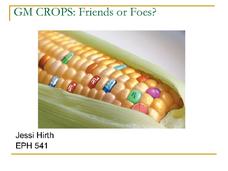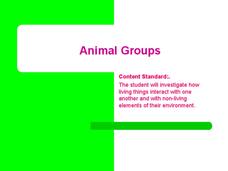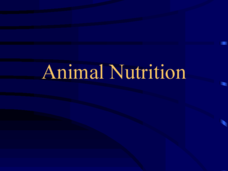Curated OER
The Healthy Train
This presentation gives the lyrics for the song, "The Healthy Train." The song goes to the melody of the classic "The Wheels on the Bus" song. It's a clever song, in that the lyrics cover all of the basic food groups found in the food...
Curated OER
Healthy Eating: Vitamins
The first five slides contain photographs of foods containing each of the major vitamins: A, B, C, D, and E. Then there is a slide explaining each of the three macro nutrients. The final slide is a low-quality graphic of the food...
Curated OER
Healthy Eating
A highly informative presentation focuses on healthy diets, food facts, the food pyramid, and healthy eating myths. There is a lot of great information in this PowerPoint, and a really fun interactive component. Perfect for your upper...
Curated OER
Chapter 16, Food Biotechnology
Although the points given on these slides are valid, the visual accessibility is poor. Consequently, many viewers would be distracted or entirely unable to view the presentation. The content is a review of microorganisms and their...
Curated OER
Healthy Eating
A short, yet very informative, presentation on the basics of healthy eating. Young dieticians view slides which have colorful photos and graphics of foods that are healthy (and not so healthy), along with information on the basic food...
Curated OER
Animal Science as Agriculture
The methods by which farming and agriculture became a valid area of study and research are detailed in this PowerPoint. Also presented are the steps involved for improving productivity and efficiency. The use of scientific method...
Curated OER
GM Crops: Friends or Foes?
Genetically modified crops—How do you feel about them? Here, explore the benefits and risks of GM crops to inform your opinion.
California State Parks
Energy Flow Through an Ecosystem
One of the key concepts in life science and biology is the cycling of energy throughout an ecosystem. Learners can take notes on the topic using the vocabulary included within the presentation. From producers making their own food...
Biology Junction
Water Biomes
Water covers more than 70 percent of Earth's surface. Scholars learn about both freshwater and saltwater biomes in a simple presentation. They compare and contrast the differences in oxygen levels, food sources, and sunlight to better...
Primary Resources
Eating a Balanced Diet
A perky presentation provides an overview of what comprises a balanced diet. Viewers discover why water is vital to our health, what the macro-nutrients are and what they provide, and how calcium is important to bones and teeth. The...
Curated OER
Biomes
Arranged as an interactive lesson, this presentation focuses on the six world biomes. Upcoming biologists click on a specific biome and a slide lists its location, description, native plants, and animals. A quiz provides learners with...
Curated OER
Respiration
This series opens with diagrams of experimental setups. A data table is displayed and questions are asked, indicating that the intent is for lab groups to perform the depicted experiments. At slide twelve, a coherent lesson about the...
Curated OER
Sustainability and the Recycling of Words
Recycling and green living isn't just for the environment anymore. Studying the use of metaphors and metonymies, especially in reference to environmental sustainability, this presentation provides viewers with plenty of food for thought....
Curated OER
The Celts
Look far back in history and you'll meet a people group called the Celts. Celts, as you'll soon find out, are a group of people who inhabited Britain 2000 years ago. Presented here, is simple information which describes a bit about...
Curated OER
Animal Nutrition, Variations, Adaptations & Regulation
Information about digestion of various food components is given in this PowerPoint. The diets of herbivores and carnivores are compared, and there are many diagrams giving details of their digestive system specializations. The...
Curated OER
Introduction to Plants
A vast overview of avascular and vascular plants, this PowerPoint displays all of the notes your botanists need to take. It lists primitive plant groups and their characteristics. It separates gymnosperms and angiosperms, also detailing...
Curated OER
Daily Life in Spanish St. Augustine 1565-1763
How do we know so much about the past? A student-crafted presentation provides viewers with images of artifacts from St. Augustine, Florida that give historians and archaeologists clues into lives already lived.
Biology Junction
Cellular Respiration
Which food molecules must be present for cellular respiration to occur? Scholars view an informative presentation to better understand the process of cellular respiration. It details each step, focusing on the locations and the four main...
Curated OER
Animal Groups
This animal science PowerPoint introduces various types of animals that live in groups. The slides contain real photographs along with explanations of why animals live in groups and what their roles are.
Curated OER
Animal Nutrition
Use this great overview to give information on all aspects of nutrition. By working their way through this PowerPoint, students review a lot of information about the digestive process. Students read many facts on a number of...
Curated OER
Social Studies: Looking at Regions
Quiz your 3rd graders on why we have regions. This regions quiz includes 16 questions on why and how we group areas into regions based on physical features, culture, politics or religion. A class discussion on technology completes this...
Curated OER
Protists
With this collection of slides, future biologists get to view photographs of protozoans from different phyla. Interspersed with the photos are bullet-style notes listing characteristics of each group. Unfortunately, most of the pictures...
Curated OER
The Colon
An outstanding presentation clarifies one of the most misunderstood and misused punctuation marks: the colon. With clear instructions about the appropriate times to use the colon and examples of proper usage,...
CFR Washington
Urbanization and Wildlife
Urbanization and how it affects wildlife is the focus of a presentation that uses statistics to make a case for concern and change.

























